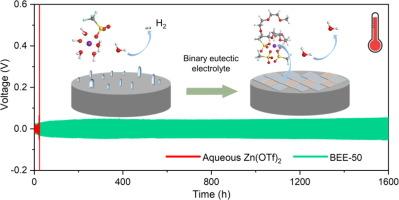用于高温界面兼容锰离子电池的二元共晶电解质设计
IF 13.1
1区 化学
Q1 Energy
引用次数: 0
摘要
水性锌离子电池(AZIBs)的劣化面临着各种挑战,如不规则的 Zn2+ 扩散、枝晶生长以及恶劣环境下电池性能的严重下降。本文提出了一种共晶电解质的设计理念,即在三氟甲基磺酸锌(Zn(OTf)2)的基础上,将长链聚合物分子聚乙二醇二甲醚(PEGDME)与 H2O 混合,重建 Zn2+ 溶解结构,并原位修饰 Zn 电极表面的吸附层。分子动力学模拟(MD)、密度泛函理论(DFT)计算与实验相结合,证明了长链聚合物-PEGDME 能有效减少副反应,改变电解质的溶解结构,优先吸附在 Zn(002) 上,实现了稳定的无树枝状 Zn 阳极。由于 PEGDME 对溶解结构和锌沉积的全面调节,在室温条件下,在 0.5 mA/cm2 和 0.5 mAh/cm2 的条件下,可稳定循环 3200 小时以上。即使在 60 °C 的高温环境下,它也能稳定工作 800 多个循环(1600 小时)。改性电解质中的 Zn||VO2 水电池在室温和高温下的循环稳定性和速率性能也得到了改善。此外,稳定和高容量 Zn||VO2 袋式电池的展示也意味着它的实际应用。本文章由计算机程序翻译,如有差异,请以英文原文为准。

A binary eutectic electrolyte design for high-temperature interface-compatible Zn-ion batteries
The deterioration of aqueous zinc-ion batteries (AZIBs) is confronted with challenges such as unregulated Zn2+ diffusion, dendrite growth and severe decay in battery performance under harsh environments. Here, a design concept of eutectic electrolyte is presented by mixing long chain polymer molecules, polyethylene glycol dimethyl ether (PEGDME), with H2O based on zinc trifluoromethyl sulfonate (Zn(OTf)2), to reconstruct the Zn2+ solvated structure and in situ modified the adsorption layer on Zn electrode surface. Molecular dynamics simulations (MD), density functional theory (DFT) calculations were combined with experiment to prove that the long-chain polymer-PEGDME could effectively reduce side reactions, change the solvation structure of the electrolyte and priority absorbed on Zn(002), achieving a stable dendrite-free Zn anode. Due to the comprehensive regulation of solvation structure and zinc deposition by PEGDME, it can stably cycle for over 3200 h at room temperature at 0.5 mA/cm2 and 0.5 mAh/cm2. Even at high-temperature environments of 60 °C, it can steadily work for more than 800 cycles (1600 h). Improved cyclic stability and rate performance of aqueous Zn||VO2 batteries in modified electrolyte were also achieved at both room and high temperatures. Beyond that, the demonstration of stable and high-capacity Zn||VO2 pouch cells also implies its practical application.
求助全文
通过发布文献求助,成功后即可免费获取论文全文。
去求助
来源期刊

Journal of Energy Chemistry
CHEMISTRY, APPLIED-CHEMISTRY, PHYSICAL
CiteScore
19.10
自引率
8.40%
发文量
3631
审稿时长
15 days
期刊介绍:
The Journal of Energy Chemistry, the official publication of Science Press and the Dalian Institute of Chemical Physics, Chinese Academy of Sciences, serves as a platform for reporting creative research and innovative applications in energy chemistry. It mainly reports on creative researches and innovative applications of chemical conversions of fossil energy, carbon dioxide, electrochemical energy and hydrogen energy, as well as the conversions of biomass and solar energy related with chemical issues to promote academic exchanges in the field of energy chemistry and to accelerate the exploration, research and development of energy science and technologies.
This journal focuses on original research papers covering various topics within energy chemistry worldwide, including:
Optimized utilization of fossil energy
Hydrogen energy
Conversion and storage of electrochemical energy
Capture, storage, and chemical conversion of carbon dioxide
Materials and nanotechnologies for energy conversion and storage
Chemistry in biomass conversion
Chemistry in the utilization of solar energy
 求助内容:
求助内容: 应助结果提醒方式:
应助结果提醒方式:


